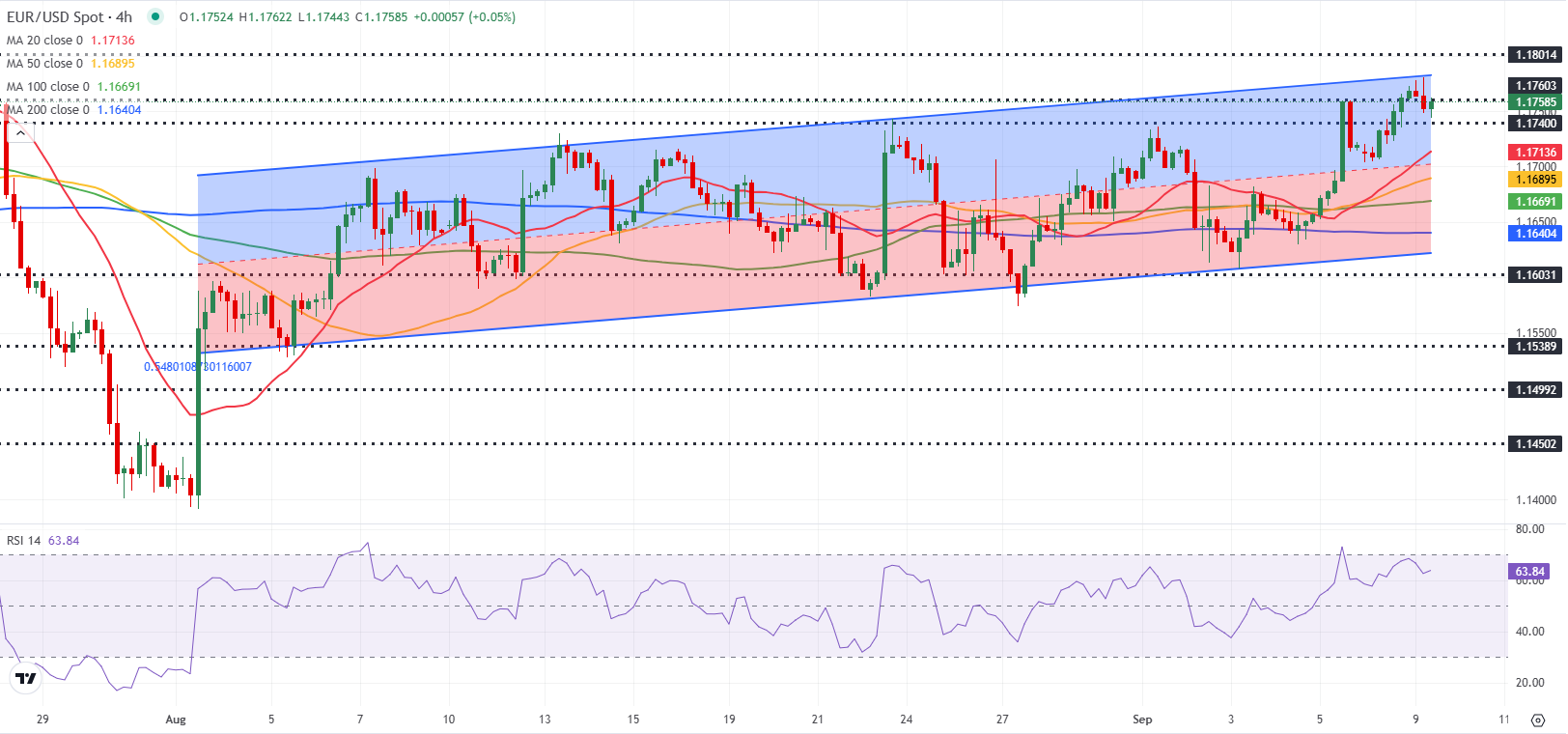- EUR/USD consolidates Monday’s gains, holds near 1.1750 early Tuesday.
- US BLS will publish preliminary benchmark revisions to employment data.
- The pair’s technical outlook suggests that the bullish bias remains intact.
EUR/USD stays in a consolidation phase at around 1.1750 in the European session after touching its highest level since late July at 1.1780 earlier in the day. The near-term technical outlook points to a bullish bias as investors move to the sidelines while waiting for the key employment-related data from the United States.
Euro Price This week
The table below shows the percentage change of Euro (EUR) against listed major currencies this week. Euro was the strongest against the US Dollar.
| USD | EUR | GBP | JPY | CAD | AUD | NZD | CHF | |
|---|---|---|---|---|---|---|---|---|
| USD | -0.40% | -0.49% | -1.07% | -0.24% | -0.89% | -0.94% | -0.67% | |
| EUR | 0.40% | -0.10% | -0.60% | 0.15% | -0.48% | -0.50% | -0.27% | |
| GBP | 0.49% | 0.10% | -0.58% | 0.25% | -0.38% | -0.40% | -0.17% | |
| JPY | 1.07% | 0.60% | 0.58% | 0.76% | 0.14% | -0.03% | 0.42% | |
| CAD | 0.24% | -0.15% | -0.25% | -0.76% | -0.56% | -0.65% | -0.43% | |
| AUD | 0.89% | 0.48% | 0.38% | -0.14% | 0.56% | -0.02% | 0.21% | |
| NZD | 0.94% | 0.50% | 0.40% | 0.03% | 0.65% | 0.02% | 0.23% | |
| CHF | 0.67% | 0.27% | 0.17% | -0.42% | 0.43% | -0.21% | -0.23% |
The heat map shows percentage changes of major currencies against each other. The base currency is picked from the left column, while the quote currency is picked from the top row. For example, if you pick the Euro from the left column and move along the horizontal line to the US Dollar, the percentage change displayed in the box will represent EUR (base)/USD (quote).
The US Dollar (USD) started the week under bearish pressure and allowed EUR/USD to push higher as markets continued to price in a dovish Federal Reserve (Fed) policy outlook following the dismal jobs data for August.
Meanwhile, French lawmakers voted to oust Prime Minister François Bayrou on Monday and President Emmanuel Macron’s office stated that he will appoint a new prime minister “in a matter of days.” As this outcome was widely anticipated, the market reaction was muted. Nevertheless, the main concern about France’s fiscal health remains in place, and investors could turn hesitant to bet on an extended Euro rally until there is clarity.
In the second half of the day, the Bureau of Labor Statistics will release preliminary benchmark revisions to the employment data. Last year, the significant downward revision to the past Nonfarm Payroll prints, published in late August, caused the Federal Reserve (Fed) to opt for a 50 basis-points rate cut in September.
A similar scenario could play out if the BLS’ revisions show that the NFP growth was much weaker than originally reported. According to the CME FedWatch Tool, markets are currently pricing in about a 12% probability of a 50 bps rate cut at next week’s policy meeting. The USD could come under renewed selling pressure and open the door for another leg higher in EUR/USD in case markets lean toward a 50 bps cut after NFP revisions. On the flip side, the USD could recover in case revisions are not significant enough, causing EUR/USD to correct lower.
EUR/USD Technical Analysis

The Relative Strength Index (RSI) indicator on the 4-hour chart holds above 60 and EUR/USD continues to trade comfortably above key Simple Moving Average (SMA) levels. On the upside, 1.1790-1.1800 (upper limit of the ascending channel, static level, round level) aligns as the next resistance level before 1.1830 (July 1 high) and 1.1900 (static level, round level).
Looking south, support levels could be spotted at 1.1700 (mid-point of the ascending channel, static level), 1.1670-1.1660 (100-period SMA, 50-day SMA) and 1.1640 (200-period SMA).
Nonfarm Payrolls FAQs
Nonfarm Payrolls (NFP) are part of the US Bureau of Labor Statistics monthly jobs report. The Nonfarm Payrolls component specifically measures the change in the number of people employed in the US during the previous month, excluding the farming industry.
The Nonfarm Payrolls figure can influence the decisions of the Federal Reserve by providing a measure of how successfully the Fed is meeting its mandate of fostering full employment and 2% inflation.
A relatively high NFP figure means more people are in employment, earning more money and therefore probably spending more. A relatively low Nonfarm Payrolls’ result, on the either hand, could mean people are struggling to find work.
The Fed will typically raise interest rates to combat high inflation triggered by low unemployment, and lower them to stimulate a stagnant labor market.
Nonfarm Payrolls generally have a positive correlation with the US Dollar. This means when payrolls’ figures come out higher-than-expected the USD tends to rally and vice versa when they are lower.
NFPs influence the US Dollar by virtue of their impact on inflation, monetary policy expectations and interest rates. A higher NFP usually means the Federal Reserve will be more tight in its monetary policy, supporting the USD.
Nonfarm Payrolls are generally negatively-correlated with the price of Gold. This means a higher-than-expected payrolls’ figure will have a depressing effect on the Gold price and vice versa.
Higher NFP generally has a positive effect on the value of the USD, and like most major commodities Gold is priced in US Dollars. If the USD gains in value, therefore, it requires less Dollars to buy an ounce of Gold.
Also, higher interest rates (typically helped higher NFPs) also lessen the attractiveness of Gold as an investment compared to staying in cash, where the money will at least earn interest.
Nonfarm Payrolls is only one component within a bigger jobs report and it can be overshadowed by the other components.
At times, when NFP come out higher-than-forecast, but the Average Weekly Earnings is lower than expected, the market has ignored the potentially inflationary effect of the headline result and interpreted the fall in earnings as deflationary.
The Participation Rate and the Average Weekly Hours components can also influence the market reaction, but only in seldom events like the “Great Resignation” or the Global Financial Crisis.







